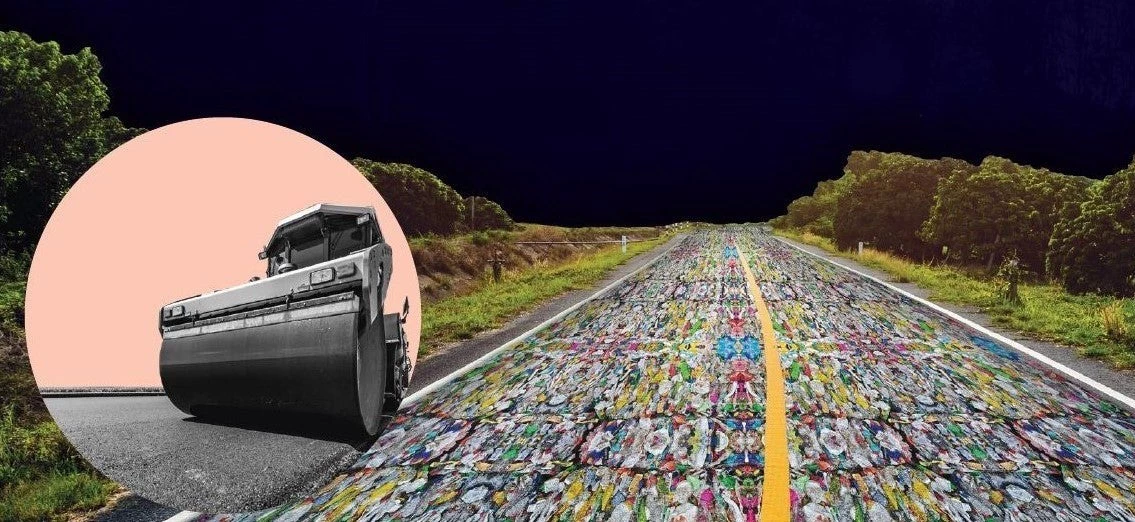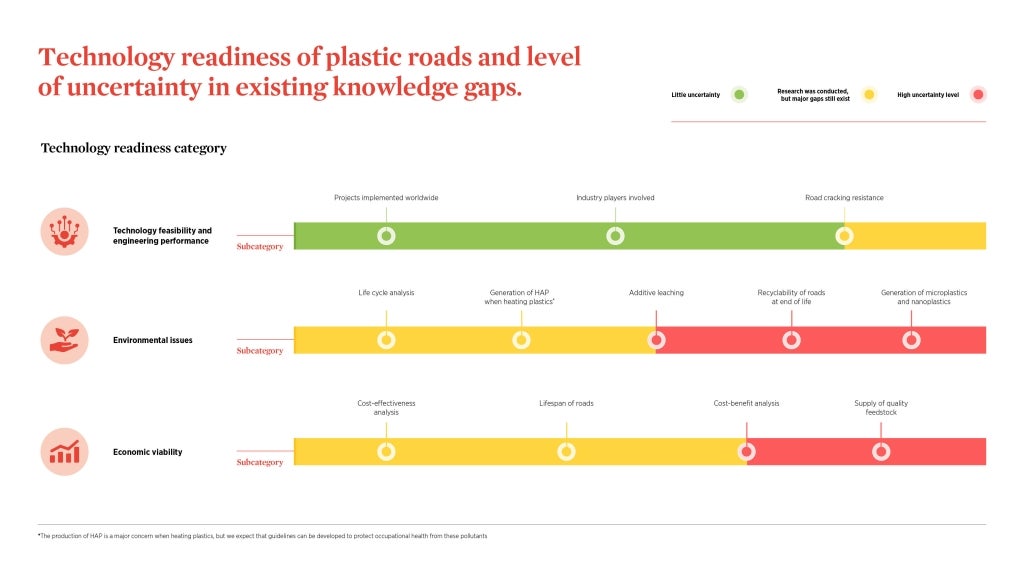 Cover image of World Bank report "Plastic Waste in Road Construction: A Path Worth Paving?"
Cover image of World Bank report "Plastic Waste in Road Construction: A Path Worth Paving?"
Plastics are ubiquitous in our daily lives, and global plastic production has skyrocketed since its commercialization in the 1950s. In 2015, we produced plastics almost equal to the combined weight of the entire human population. If we continue business as usual, the amount of plastic waste produced globally will double to a whopping 430 million metric tons in 2040 and ocean plastic will outweigh all the fish in the sea by 2050, causing species to die, damaging entire ecosystems, and accelerating climate change.
South Asia struggles with plastics pollution. The region leads the world in open dumping of waste at 334 million metric tons per year, of which 40 million is plastic. Without action, South Asia will double its mismanaged waste to 661 million metric tons per year by 2050, earning the region the unwanted distinction as one the world’s leading producer of plastic pollution. Also, plastics manufacturing leads to greenhouse gas emissions and with already rising sea levels and ecological collapse threatening environments, South Asian countries are at an greater risk from severe impacts of climate change.
As the world scrambles to find innovative solutions to the plastics waste conundrum, a road less traveled is the use of non-recyclable plastic waste in paved roads. A new report by the World Bank Plastic Waste in Road Construction: A Path Worth Paving? examines currently available scientific knowledge on repurposing plastic waste for road construction while protecting human health and the environment.

The idea is to substitute virgin polymers—widely used to modify bitumen, a binding material in road construction—as a useful final sink for unrecycled plastics. If we follow this route—and assuming approximately one ton of plastics is needed for one kilometer of road—it has the potential to divert 57,803 single-use food containers, 2.5 million straws, or 166,667 single-use grocery bags from becoming ocean waste. Further, plastic roads are also expected to yield GHG reductions: one kilometer of plastic road saves approximately three tons of carbon dioxide, as compared to incinerating plastic waste.
Solid paved roads, which are vital to the development agenda, are still missing in many fast-growing developing countries across South Asia. Roads are the heartbeat of economic and social activity as well as trade, linking producers to consumers, people to jobs, kids to schools, and patients to hospitals, thereby boosting economic activity and reducing poverty. If plastic trash can be used to build essential infrastructure, we can provide transportation to citizens AND contribute to a cleaner planet.
But there is one caveat…
We Don't Know What We Don't Know, Yet
While using recycled plastics in road construction is not new, the concept has not been put through the rigor and discipline of evaluating its environmental considerations. India has led the way in plastic road construction, with Dr. Rajagopalan Vasudevan, the “plastic man of India,” patenting a plastic road construction method in 2006. Since then, India has built more than 2,500 km (about half the width of the United States) of plastic roads and globally too, plastic roads are proliferating in more than 15 countries with projects being piloted or under construction.
However, here are the unknowns that need to be vetted through rigorous scientific research:
- While conventional roads and tire wear constitute a significant source of microplastics, microplastic generation from plastic roads specifically needs to be better understood.
- The potential leaching of plastic additives and engineering specifications such as cracking resistance need to be thoroughly studied.
- Guidelines need to be developed to protect workers' occupational health from generating and inhaling hazardous particles while processing plastics at a high temperature.
Conventional roads are highly recyclable, but it remains unknown if plastic roads can be recycled at the end-of-life.

Bangladesh: Tackling Climate Shocks with Resilient, Plastic Roads
Encouraged by a successful short pilot with constructing a rural road using plastic waste in Gazipur, a climate vulnerable Bangladesh is joining hands with the World Bank to explore the use of resilient material, including plastic waste, to construct roads in eight of its administrative divisions. The goal is to both study whether these roads better withstand the shocks of natural disasters and undertake never-before scientific research to measure and monitor the extent to which microplastics—if any—in plastic roads cause environmental damage.
With only two-thirds of the country sitting at less than 15 feet above sea level and with high tides claiming more land each year, Bangladesh is increasingly susceptible to extreme weather events. Rural roads, a lifeline for Bangladeshis, become not only unpassable and unreliable, but even dangerous for use as shelters from flooding or collecting social and economic recovery assistance in the aftermath of disasters. The first modest pilot on the plastic road has showed promise: the plastic road has withstood damage from floods, resisted bleeding from bitumen in the hottest of summers, was more cost-effective to construct than only using bitumen, and a cleaner way out for hazardous plastic waste than overgrowing landfills.
Taking the High Road Towards Sustainability
Though knowledge gaps remain, the use of plastic waste in roads can prevent a significant portion of unrecyclable plastic waste from becoming a large-scale pollutant in the environment. But, trying to solve one crisis while adding to another is not the answer. We hope that this report stimulates a rigorous debate on how we can work together on viable solutions that are good for the people, the environment, and our collective well-being. Time and evidence-based research conducted concurrently with pilot projects such as the one in Bangladesh, can ultimately tell us if plastic roads are a path worth paving.




Join the Conversation